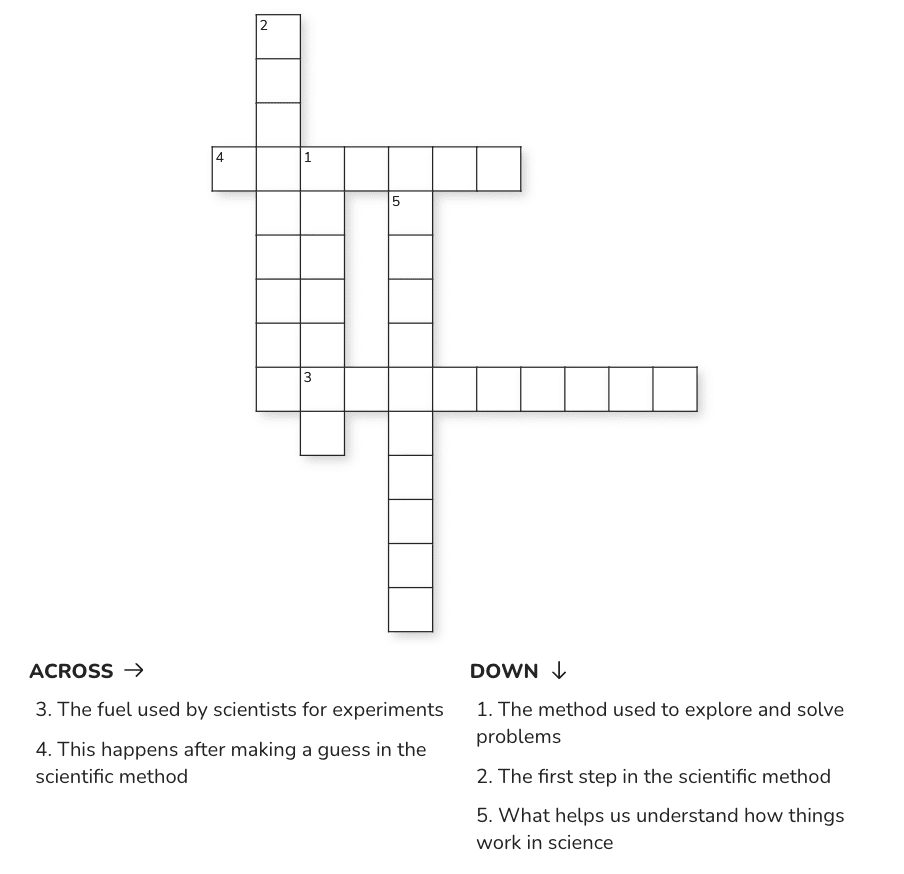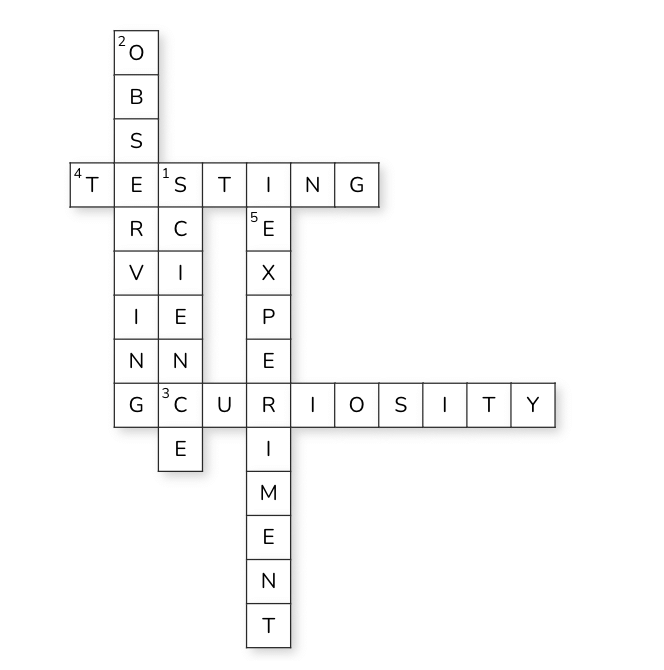Assignment: The Wonderful World of Science | Science for Class 6 PDF Download
| Table of contents |

|
| Multiple Choice Questions (MCQs) |

|
| Short Question/Answer (Q&A) |

|
| Activity-Based Questions |

|
| Research-Based Question |

|
| Crossword Puzzle |

|
Multiple Choice Questions (MCQs)
What is the first step in the scientific method?
(A) Testing a guess
(B) Analyzing results
(C) Observing something that interests you
(D) Making a guess
Solution: (C) Observing something that interests you
The first step in the scientific method is to observe something that catches your attention or that you do not understand, leading to questions.Why is curiosity important in science?
(A) It helps you memorize facts
(B) It leads to new discoveries and questions
(C) It allows you to avoid experiments
(D) It prevents errors in science
Solution: (B) It leads to new discoveries and questions
Curiosity drives the process of asking questions, exploring, and making new discoveries, which is at the heart of scientific inquiry.In the scientific method, what do you do after making a guess (hypothesis)?
(A) Analyze results
(B) Test your guess through experiments or more observations
(C) Ask more questions
(D) Ignore the results
Solution: (B) Test your guess through experiments or more observations
After making a guess, scientists test it through controlled experiments or further observations.What is the key to learning science effectively?
(A) Memorizing the textbook
(B) Being curious and observing surroundings
(C) Avoiding experiments
(D) Watching scientific videos
Solution: (B) Being curious and observing surroundings
Being curious and observing your surroundings is essential for learning science effectively, as it encourages questioning and exploration.Who follows the scientific method?
(A) Only professional scientists
(B) Only students
(C) Everyone who tries to solve problems or discover new things
(D) Only teachers
Solution: (C) Everyone who tries to solve problems or discover new things
The scientific method is used by anyone who seeks to find answers or solve problems, whether they are scientists, students, or everyday people.
Short Question/Answer (Q&A)
Why is the scientific method important in understanding the world?
Solution: The scientific method helps us find answers by observing, asking questions, making guesses, testing them, and analyzing results. It is a systematic approach to solving problems and understanding how things work.What does science help us to explore and understand?
Solution: Science helps us explore and understand the world around us, from the smallest particles to the vastness of outer space. It explains natural phenomena and answers many of the mysteries of the universe.How does curiosity play a role in science?
Solution: Curiosity drives us to ask questions about the world around us, leading to new discoveries and deeper understanding. It encourages us to explore, test hypotheses, and find answers.What are some ways science is used in daily life?
Solution: Science is used in daily life in various ways, such as understanding the weather, cooking food, maintaining health, using technology, and solving everyday problems like fixing a flat tire.Why is science like a jigsaw puzzle?
Solution: Science is like a jigsaw puzzle because every new discovery adds a new piece of knowledge, which helps us understand more. As we learn, more questions arise, and the puzzle continues to grow.
Activity-Based Questions
Activity 1: Write about a similar problem that you tried to solve. What steps did you take?
Solution: An example could be fixing a leaking faucet. I first observed the leak and guessed that the pipe might be loose. Then, I turned off the water supply and checked the pipe. After confirming it was loose, I tightened it, tested it, and observed no further leak. This follows the scientific method of observing, guessing, testing, and analyzing results.Activity 2: Describe a daily life situation where you feel someone was following the scientific method.
Solution: One example could be when a person is trying to figure out why their phone isn't charging. They might first check the charger, test it with another phone, guess it could be a faulty wire, and then test their guess by using a different charger. This shows the application of the scientific method to troubleshoot everyday problems.
Research-Based Question
1. What are some everyday examples where you apply the scientific method without realizing it?
Solution: Everyday examples of the scientific method include trying to figure out why a light bulb isn't working (checking the bulb, testing the switch, etc.) or figuring out why a plant isn’t growing (checking soil, sunlight, water, etc.). These situations involve observing, making guesses, and testing to find solutions.
Crossword Puzzle

Solution:
|
67 videos|289 docs|27 tests
|
















